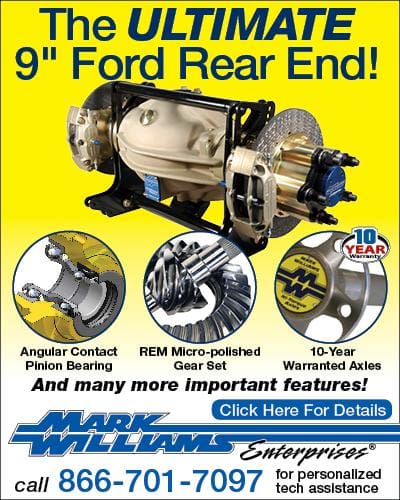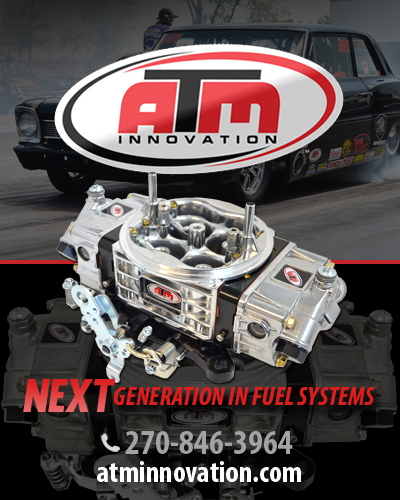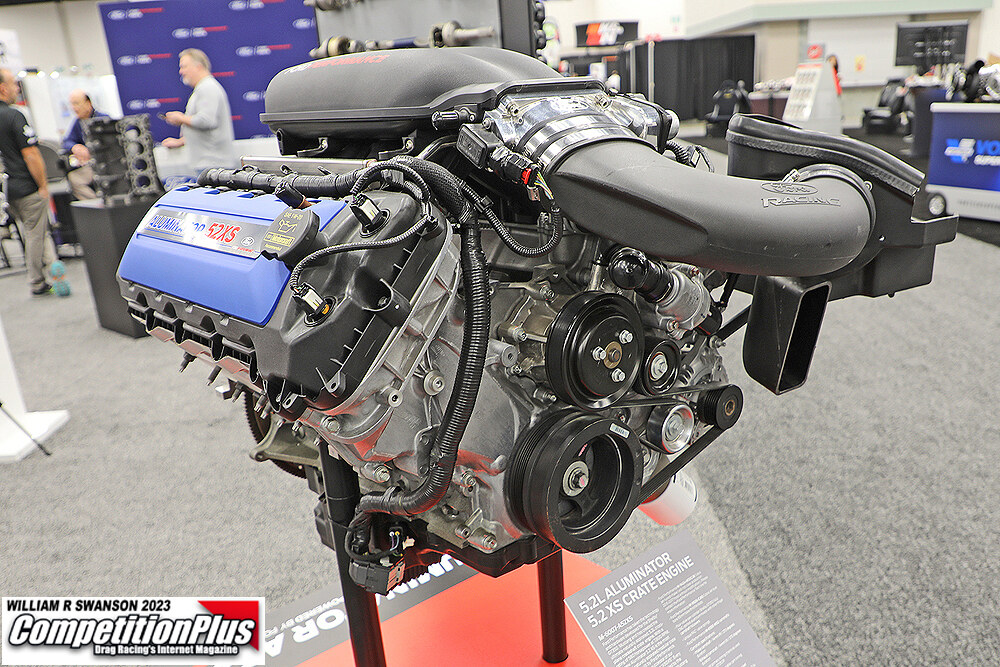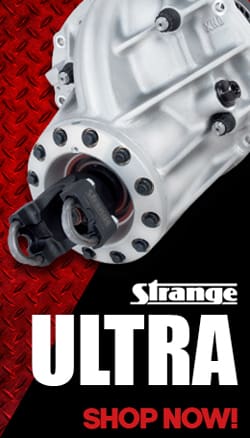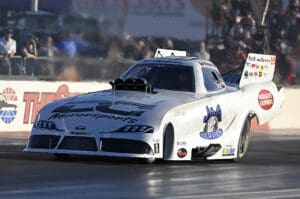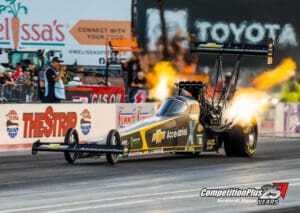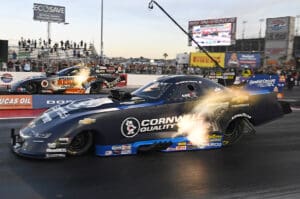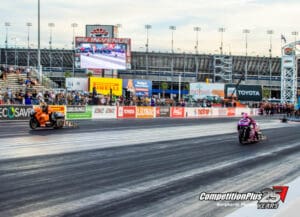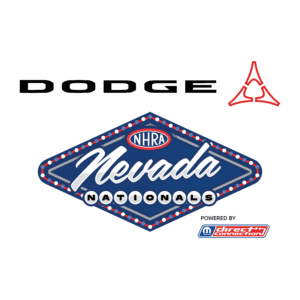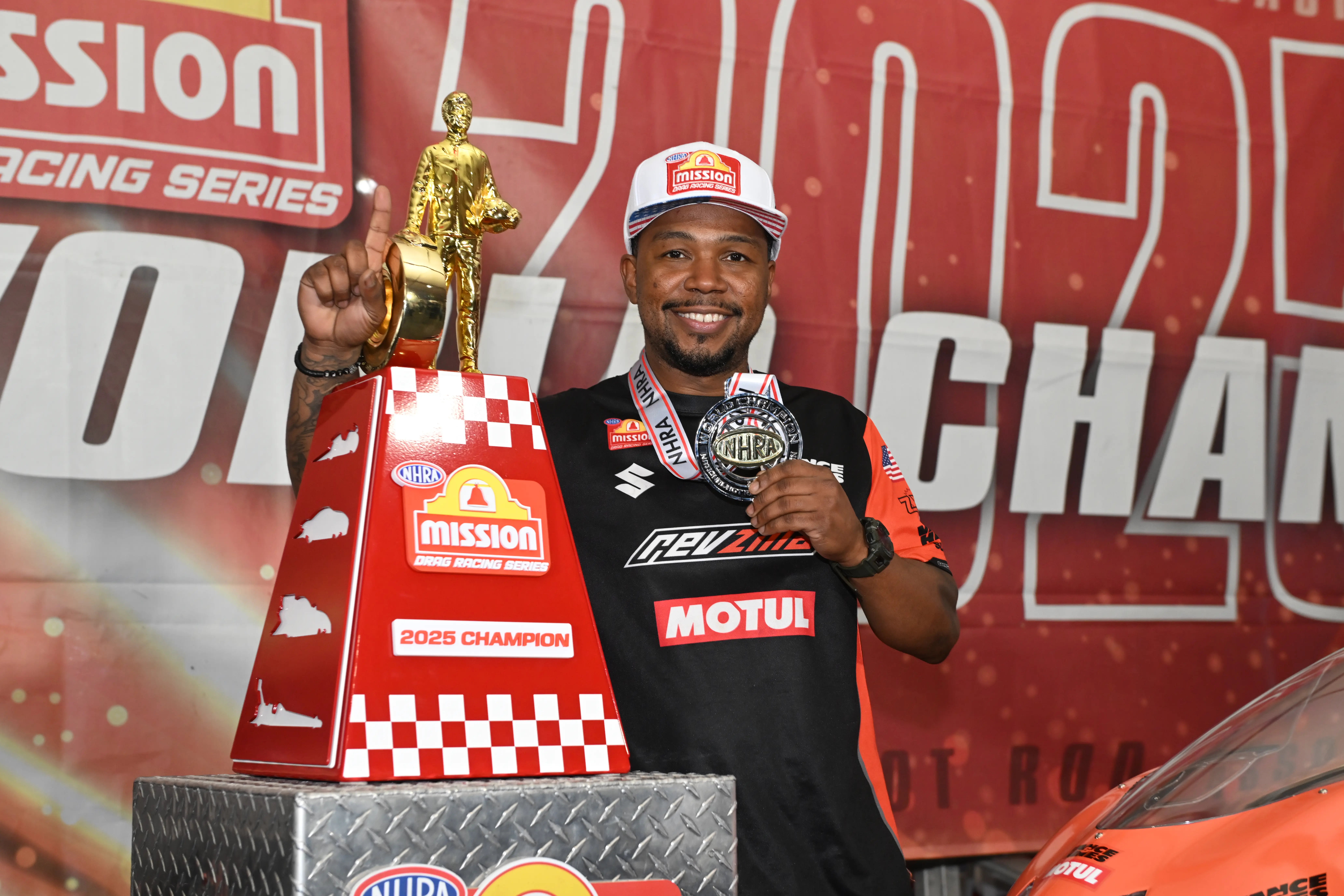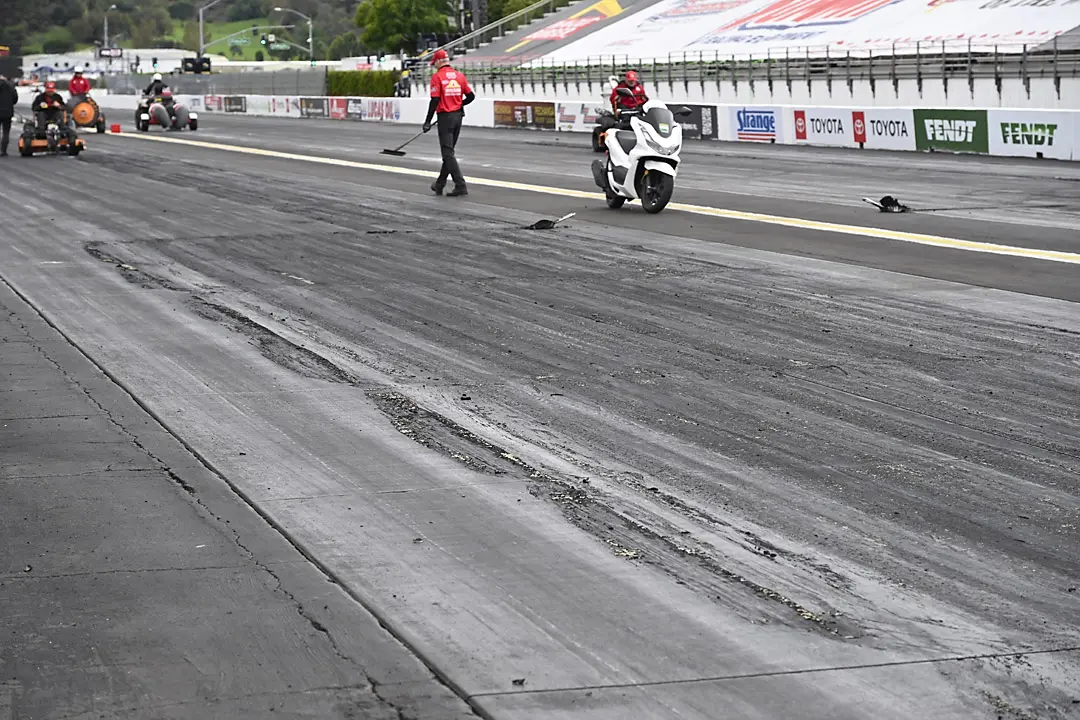
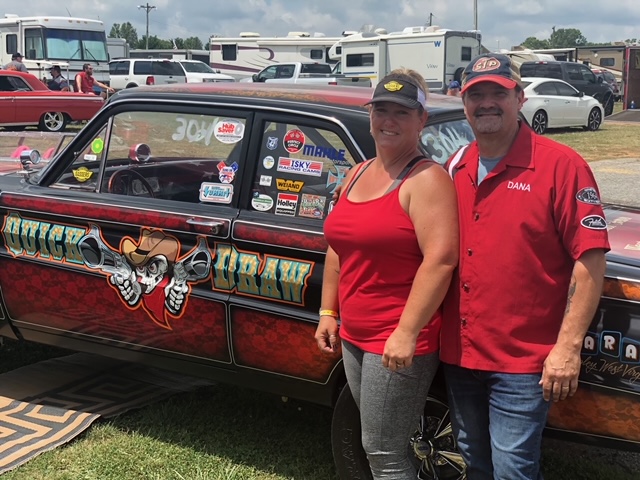 Dana and Diana Casto race a 1964 Ford two-door they rescued from a creek.
Dana and Diana Casto race a 1964 Ford two-door they rescued from a creek.
They forked over $200 to purchase the Falcon, winched it out of its resting — rusting? — place and hauled it home to the outskirts of (believe it or not) Ripley, W.Va. And that’s how a four-year restoration project began — a mission that now finds Diana, a rookie drag racer, behind the wheel in Southeast Gassers Association competition.
“I told Diana we heard banjos about three miles before we got to the turnoff for their road, and then drove another five miles,” Dana said. “They had parked the car out of the way at some point, and I guess they kept parking it further and further away from the house because they had so many other ‘lawn treasures’ that they had to make room for, and it just ended up that it was in the creek.
“When we got down to where the car was, you could literally look through one side and see grass on the other side. But the structure was good. Everything that we needed it to be was there.”
‘Barn finds’ aren’t entirely unusual to drag racing. The Castos, however, are, and they may very well represent the epitome of low-buck racers.
They haul their ‘Quick Draw’ C/Gas Falcon to SEGA races on an open trailer — the same trailer they use for hauling hay and other items at home in Sandyville, an unincorporated town of 1,700 in Jackson County.
Last year, when the car made its debut with Dana driving, the Castos slept in a small tent perched atop the trailer. Motel rooms? Sorry, that’s not in the budget for a couple of school bus drivers. The generator they use to charge the battery in ‘Quick Draw’ also powers the coffee pot.
Their tow vehicle is the pickup that’s Diana’s every-day ride, whether it’s for farm use or serving as the family car. The truck, dubbed the “Hillbilly HIlton,” now sports a camper shell that shelters the Castos from the elements while they sleep at the track.
“We got the top because it never failed that when we left to go to a race, it would rain on us,” Diana said. “I had our sleeping bags in garbage bags, we had our pillows in garbage bags, and no matter how hard I tried, stuff got wet.”
Southeast Gassers Association founder Quain Stott, a former IHRA world champion in Pro Modified, said the Castos are the type of people the group not only hopes to draw, but needs to attract.
“We started this to help give people like them a place to race where ‘first to the finish line wins,’ ” Stott said. “Racing had started getting more expensive to do, and it lost a lot of its low-budget racers because they felt like they couldn’t hang. Diana and Dana are toughing it out and staying and fighting these high-dollar teams, we’ll call them. They’re hanging in there, and I see improvements every race. I honestly think that, in time, they will be very competitive because they’ve got that no-give-up attitude.”
With the exception of some machine work by Billy Lloyd and Augustus “Hemi” Atkins and the custom lettering by Larry Conway, the Castos did all of the work themselves, including the car’s paint and the impressive ‘lacework’ on its sides. The ‘Quick Draw’ character, holding twin six-shooters, is affectionately dubbed Gus, and is Diana’s way of paying homage to Augustus McCrae, the lead character portrayed by Robert Duval in the 1989 TV mini-series ‘Lonesome Dove.’
To understand why the Castos have gone racing, you have to know their background.
Dana, who is 52, was an ‘Army brat’ who was born at Fort Bragg, N.C. He followed in his father’s footsteps by enlisting in the service and spending 14 years as a military police officer before returning to civilian life.
Diana, 44, describes herself as a tomboy who grew up on a farm just 10 miles from where she and Dana make their home. Everything she drove on her parents’ farm had a standard transmission, as did her first car, a 1990 Chevy Cavalier with a four-cylinder engine and a 5-speed. She also admits to being fueled by naysayers. “If you told me I couldn’t do something, that would make me that much more determined to do it and prove you wrong — and do it 10 times better than you,” she said.
 Before Dana and Diana began dating, he owned a ‘41 Willys coupe powered by a supercharged 392 Hemi. That was a car he built after coming back from a deployment to Iraq with combat pay burning a hole in his pocket. But the Willys was a passion that eventually got him in some financial hot water.
Before Dana and Diana began dating, he owned a ‘41 Willys coupe powered by a supercharged 392 Hemi. That was a car he built after coming back from a deployment to Iraq with combat pay burning a hole in his pocket. But the Willys was a passion that eventually got him in some financial hot water.
“I ended up getting a divorce and bachelored for too long,” he said. “When me and Diana got together, finances were really tight, I got behind, and I had to sell the car.”
“He was doing his thing however he wanted to do it,” Diana said. “I told him, ‘You’re either going to sell that car or we’re going to have to live in it,’ because they were getting ready to foreclose on his house, which had become our house. I told him, ‘I promise you, when we get on our feet, I will help you build another car.’ ”
To reach that financial stage took “about four or five years,” she said, and their search for the car they wanted led them to the creek outside Glenville, W.Va.
Dana said he had “never really had an opportunity” to pursue racing in the manner he wanted, but he always found a way to stay involved. But this time, he wanted to give up driving racecars and let his wife have a crack at it. She had plenty of experience around farm equipment, but none drag racing.
“I’d been there, done that. She grew up on a farm working with her mom and dad, doing everything in the world, driving tractors and messing with cows and horses,” Dana said. “This was kind of a new experience for her, and I wanted to share that with her.
“And I got just as much enjoyment out of watching her get into it and progress, plus it gave her an equal say in everything going on with the car — and she was literally there with me through every part of the process. This is ‘our car.’ I had buddies telling me, ‘You need to do this, that and the other,’ and I said, ‘No, Diana doesn’t want to do that, so we’re doing it this way.’ It made the whole build something we could cherish together. We were under the car together, we built our own headers together — everything that we did, she was right there with me. Watching the surprise and excitement of things coming together for her, I enjoyed that. The fruits of our labor were coming into their own. It was my chance to enjoy it vicariously for her.”
“Everything that we needed to have done to the car, we did it ourselves,” Diana said. “If we didn’t know how to do it, then Dana was Googling it or looking on YouTube. Everything has been done by us. Growing up, if we didn’t have it, my dad built it, so this really isn’t anything new for me. That saying “it’s built, not bought,’ that’s us. We can’t afford to farm out anything.”
And ‘Quick Draw’ was completed only because Dana performed some masterful bartering to eventually reach the finish line.
“A lot of people can turn a car out maybe in a year or less, and if we had unlimited funds we could order something and have it shipped to us,” he said. “But what we would do is, if I found a good deal on a part, we’d go get it, and we might have to travel 100 miles or more to get it. If we’d find something that was better, we’d sell the first thing and use the money from that on the next thing.”
One example is the tunnel ram atop the 306 cubic-inch engine. The Castos drove to Winston-Salem, N.C., to purchase a tunnel ram equipped with a pair of new 450 cfm carburetors for $400. The carbs weren’t going to be big enough for the engine Dana was building, so he shopped them around until he was able to get $350. They still had the tunnel ram, and now they had $400 to buy the carburetors they needed.
“We promised each other from the beginning that we’re not going to go beyond our means and take a chance on losing something,” Dana said. “Diana’s taught me a lot like that. She’s eight years younger than me, but I think I’ve grown up in the time we’ve been together. She’s got a lot of common sense and stability.”
She also possesses a sense of daring, which isn’t surprising, given her tomboy attitude. Dana was well aware of that when he let Diana drive his brother’s 2009 Mustang.
“By the time we got home, I said to Dana, ‘If there’s any way possible we could ever pull this off, we have to have one of these,’ ” Diana said. “It was a joke, but about two weeks later — I was working at a hardware store as a cashier — he pulled up out front of the store and said, ‘Will this one work?’ ”
He had bought her an ’09 Mustang GT that had only 15,000 miles on the odometer. It has since become Dana’s daily driver, with 270,000 miles on it, some of which included Diana’s memorable first trip down the track at the now-shuttered Kanawha Valley Dragway.
“I pulled up to the water box and they told me I needed to do a burnout. I said, ‘I don’t know how,’ ” she said. “The guy just looked at me. He said, ‘No, you need to do a burnout to clean off the tires.’ I said, ‘OK.’ I still didn’t know what to do, so I pulled up to the lights. I thought, ‘OK, you take off hard and drive it,’ but where the tires were still wet, every time I grabbed a gear, it started fishtailing. I thought it was fun. I never lifted, never got out of it.
 “That probably did more damage than anything,” she added with a laugh, “because I realized how much fun this is.”
“That probably did more damage than anything,” she added with a laugh, “because I realized how much fun this is.”
Fast-forward to the Falcon found in the creek. The Castos had already acquired a Falcon, and it was going to be a “donor car” to the one they eventually tracked down. They originally planned to build it as “a nice, not radical but a little angry street car,” Diana said for car shows and around-town use.
But then they got wind of SEGA and decided to go drag racing. The automatic transmission they had wanted to use wasn’t permitted by SEGA rules, and Dana’s Facebook post asking why that wasn’t allowed prompted an inspired discussion of more than 1,000 posts. Eventually, it led to Stott replying and asking Dana to call him to hear about SEGA’s purpose and his insistence on straight-drive transmissions. That post caught Dana completely off-guard.
“I knew of Quain Stott from the Pro Mod days and match races,” Dana said. “He was always kind of my look-up-to-people because he came from nothing. He came from basically nothing and built his way into that, and I just always loved that.
“I asked Diana, ‘Why does Quain Stott want to talk to me? I’m nothing, I’m nobody.’ She said, ‘Give him your number.’ We spent about 45 minutes talking about things, and he explained to me why they didn’t do the automatic stuff.
“He invited us down to Mooresville to a SEGA race and we went. He said our car was built exactly like they like to see them built except for the automatic. We loved it, hung out with people, and on the way home I looked over at Diana and asked, ‘What do you think?’ She said, ‘I think you better find a place to trade that automatic for a 4-speed.’ ”
He took her advice to heart, and Larry Conway provided the finishing touches with the custom artwork in February 2020. It was the piece de resistance before the car hit the track, and makes ‘Quick Draw’ one of the most distinctive SEGA pieces.
“He contacted us and said, ‘Guys, I would love to put my lettering on your car,’ ” Dana said. “We had checked with a few people on getting lettering done, and it was about $2,000. We just don’t have that kind of money. I told him we couldn’t pay him the kind of money we know he’s able to get. He said, ‘You don’t understand what I’m saying. I want to letter your car. I want my lettering on your car.’ ”
In 2020, the car made its debut at Union, S.C., with Dana doing the driving. His first run was memorable.
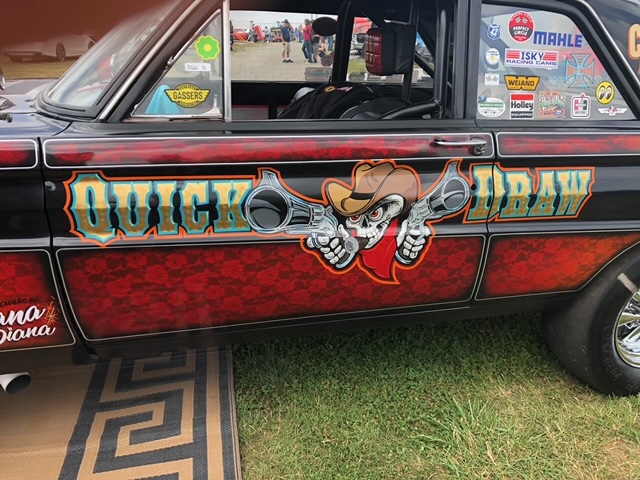 “It was the first time the car had ever seen the blacktop,” Dana said. “I launched the car, and one of the SEGA back-up girls went out on the track and started picking stuff up. At first, Diana thought I’d broken something and asked her (the back-up girl) what came out of the car. She said, ‘Gravel and mud.’ Creek gravel and mud came out of that frame after four years of us working on it.”
“It was the first time the car had ever seen the blacktop,” Dana said. “I launched the car, and one of the SEGA back-up girls went out on the track and started picking stuff up. At first, Diana thought I’d broken something and asked her (the back-up girl) what came out of the car. She said, ‘Gravel and mud.’ Creek gravel and mud came out of that frame after four years of us working on it.”
That literal shake-down pass was the first of numerous surprises as Dana finished 10th in the C/Gas standings.
“Every race last year, it was a completely different car because we were changing the suspension or tires or playing around with little things here and there,” Diana said. “He was still getting comfortable with the car, too, and he figured out he wasn’t launching hard enough. At the beginning of this year, he said, ‘OK, the car’s good — your turn.’ ”
Her first victory came in the 2021 season-opening event at Shadyside Dragway in Shelby, N.C. As the driver of the slowest in C/Gas that weekend, Diana was paired against No. 1 qualifier Larry Floyd in the ‘Stud Muffin’ Chevy station wagon. She said she had shifted into third gear before it “registered in my brain that he had red-lighted.”
That was the beginning of her surprises for the day.
“I didn’t know how it worked after first round, and Larry told me I had a bye in the second round,” she said. “I asked him, ‘What are you talking about?’ He said, “I qualified first, I had a second-round bye. You got my bye, you’re going to the third round.
“Now my heart’s in my throat, I’m automatically sick, and my nerves are bad anyway so that just made it worse.”
Just as surprised was Dana, whose focus had been only on ‘Quick Draw.’ He hadn’t noticed Floyd’s miscue, assumed his wife had been eliminated and turned to walk back to the pits.
“All of a sudden one of the back-up girls runs up and hugs me, ‘Whoo-hoo, I’m so excited!’ ” he said. “I’m like, ‘What are we excited about?’ ‘We won! We won!’ Really? Oh, my God, I’ve got to get back to the pits and hook up the battery charger, I’ve got to do the crew chief thing now. I don’t get to go back and relax, I’ve got to get ready for the next round.’
“She’s already exceeded my expectations and what I was capable of doing. She’s gone rounds, and she’s improved tremendously.”
 In fact, Diana Casto is eighth in the C/Gas standings entering this weekend’s July 23-24 event at Wagler Motorsports Park in Lyons, Ind. And even though she’s four races and 30-some passes into her career, she’s convinced the SEGA scene is where she and Dana belong — now and in the future.
In fact, Diana Casto is eighth in the C/Gas standings entering this weekend’s July 23-24 event at Wagler Motorsports Park in Lyons, Ind. And even though she’s four races and 30-some passes into her career, she’s convinced the SEGA scene is where she and Dana belong — now and in the future.
“Once we went to a SEGA race for the first time, I told Dana, ‘We’ve got to get a 4-speed in this car, this is the people I wanna race with,’ because it wasn’t just the racing, it was the people,” Diana said. “We had my daughter and her fiance with us and my son Tyler, who was about 12 at the time.
“I’ve gotten my mom involved in it, too, because last year the only thing we got from her was ‘Why are you putting all this money into this? Why are you putting all these miles on your truck?’ We explained to her about the family atmosphere. Racing the car is a perk to going to the race and spending the weekend with my friends and family. SEGA is just … it’s amazing. If somebody breaks, everybody’s right there. If somebody needs a part, if somebody blows an engine, somebody’s like, ‘Here’s an extra one, let’s throw it in there.’ We wouldn’t have made it to all the races last year — we’ve never missed a race, and we are the tadpole in the group — without some help.”
The Castos, with the shoestring budget and outgoing personalities, are carving their own niche within the sport, Stott said, and in doing so, are helping him fulfill his vision he wants the Southeast Gassers to represent.
“It’s so neat to see them out there as a family, and they’re not the only ones out there,” he said. “The way that it’s set up, you don’t have to win to enjoy this. The fans love people like them as much as the people that win the race because the fans are seeing that that’s a low-buck team and that they’re out there. They’ve probably got a bigger fan base than some of the high-dollar teams that’re winning races. They’re usually there ‘til long after a race is over. They’re usually leaving when I leave. They just love it, and the fans love them.”










